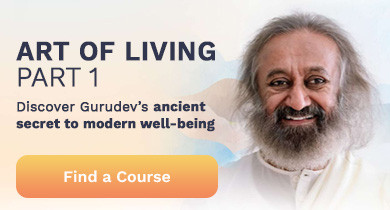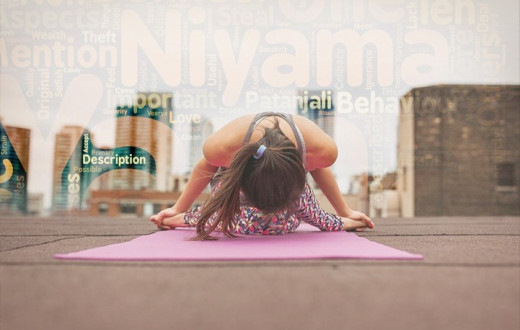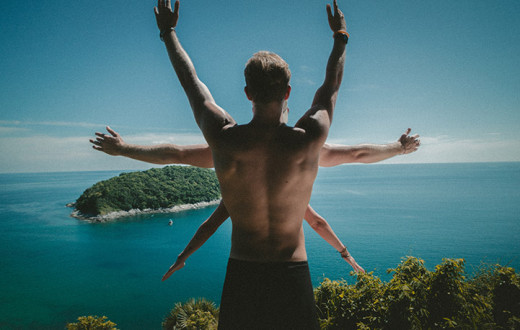Golf is known as a laid-back sport that requires little effort or physical activity. However, what few people outside the golf world realize is the intimate connection needed between the mind and body in order to excel at the game. Golf requires the ability to control minute movements within the body, and one slip of the wrist can mean a missed hole and lost game. Whether you are playing a casual game with friends or are training for a PGA tour, performanced can be naturally enhanced by increasing physical health and connecting the mind to the body.
Enhance your game!
Few golfers realize that incorrect posture while golfing increases the chances of sustaining injuries. So how does one eliminate the risk of physical injury without compromising enjoyment? Like most questions on our blog, the answer is simple: practice yoga!
Yoga is an ancient technique that enhances the ability of all people to reach their full physical and mental potential. Athletes can especially reap the benefits of yoga, as it allows them to enter what exercise expert Dr. John Douillard calls “the Zone,” which is the mental and physical space where athletes perform at their highest and feel that their performances are effortless. According to Dr. Douillard, in order to enter the Zone deliberately, the brain must enter an alpha state, which can be induced by coordinating the breath to the movement of the body. By using the body to calm the mind, athletes can think clearly and access their peak level of performance easily.
Beyond the mental benefits of yoga for golfers, yoga stretches the body and strengthens the spine, which allows for good posture and prevents back ache and cramps.
If you want to improve your golf game, then get started with these basic yoga postures to keep injuries at bay and enhance your golfing experience:
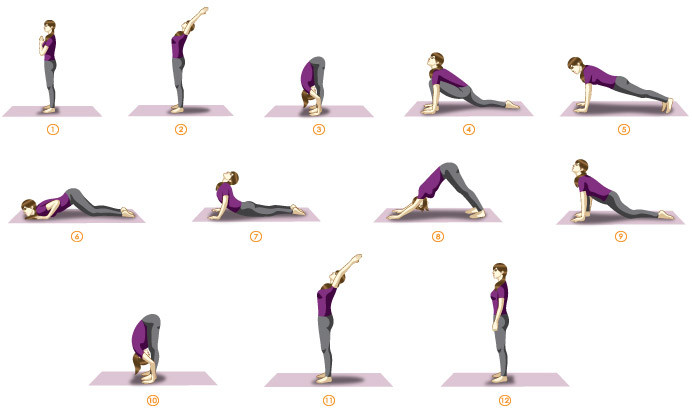
The Sun Salutation exercise is a combination of 12 different yoga postures that stretch every part of the body, including shoulders, arms, chest, legs, hamstrings, and back. These postures are useful for golf players as they strengthen the entire body and boost the stamina.

2. Marjariasana
(Cat pose)
- Come onto your fours. Form a table such that your back forms the table top and your hands and feet form the legs of the table.
- Keep your arms perpendicular to the floor, with the hands directly under the shoulders and flat on the ground; your knees are hip-width apart.
- Look straight ahead.
- As you inhale, raise your chin and tilt your head back, push your navel downwards and raise your tailbone. Compress your buttocks. Do you feel a slight tingle here?
- Hold the Cat pose and take long, deep breaths.
- Follow this by a countermovement: As you exhale, drop your chin to your chest and arch your back up as much as you can; relax the buttocks.
- Hold this pose for a few seconds before you return to the initial table-like stage.
- Continue five or six rounds before you come out of this yoga posture.
Cat pose brings flexibility to the spine, strengthens wrists and shoulders, relaxes the mind, and improves blood circulation. This posture is great for golf players as it releases tension from the upper half of the body.
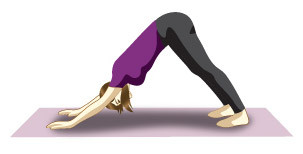
3. Adho Mukho Svanasana
(Downward facing dog pose)
- Come onto your fours. Form a table such that your back forms the table top and your hands and feet form the legs of the table.
- As you breath out lift the hips up, straightening the knees and elbows, form an inverted V-shape with the body.
- Hands are shoulder width apart, feet are hip width apart and parallel to each other. Toes point straight ahead.
- Press your hands into the ground. Widen through the shoulder blades. Keep the neck lengthened by touching the ears to the inner arms.
- Hold the downward dog pose and take long deep breaths. Look towards the navel.
- Exhale. Bend the knees, return to table pose. Relax.
Downward Facing Dog pose brings strength to the arms, shoulders, legs, and feet.This pose lengthens the spine, strengthens the muscles, and increases circulation to the brain. It also helps relieve headache and fatigue, which is common after playing golf for a long period of time in the sun.

4. Poorvottanasana
(Upward plank pose)
- Sit up with the legs stretched out straight in front of you, keeping the feet together and the spine erect.
- Place the palms on the floor around the waist or at shoulder level, fingertips pointing away from you. Do not bend the arms.
- Lean back and support the weight of your body with your hands.
- Breathing in, raise the pelvis up, keeping the whole body straight.
- Keep your knees straight and bring the feet flat to the floor. Place the toes on the ground and the sole will then tend to be on the ground. Let the head fall back towards the floor.
- Hold the pose and continue breathing.
- As you exhale, come back to a sitting position and relax.
- Repeat the posture with your fingers pointing in the opposite direction.
The Upward plank pose strengthens the wrists, arms, shoulders, back and spine. It also stretches the legs and hips, helping you stay on the golf course with much more vigor and zest. This posture helps pull off those powerful shots by lending more strength to the wrists and arms and also helps keep problems like Golfer's elbow at bay.
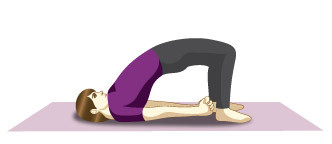
5. Setu Bandhasana
(Bridge pose)
- To begin, lie on your back.
- Fold your knees and keep your feet hip distance apart on the floor, 10-12 inches from your pelvis, with knees and ankles in a straight line.
- Keep your arms beside your body, palms facing down.
- Inhaling, slowly lift your lower back, middle back and upper back off the floor; gently roll in the shoulders; touch the chest to the chin without bringing the chin down, supporting your weight with your shoulders, arms and feet. Feel your bottom firm up in this pose. Both the thighs are parallel to each other and to the floor.
- If you wish, you could interlace the fingers and push the hands on the floor to lift the torso a little more up, or you could support your back with your palms.
- Keep breathing easily.
- Hold the posture for a minute or two and exhale as you gently release the pose.
Bridge Pose strengthens the back muscles and releases tension, simultaneously calming the brain by reducing anxiety and stress.This posture stretches the chest, neck, and spine, giving your body more flexibility.
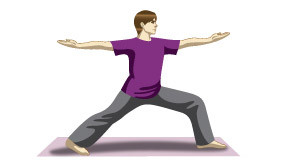
6. Veerbhadrasana
(Warrior pose)
- Stand straight with your legs wide apart by a distance of at least 3-4 feet.
- Turn your right foot out by 90 degrees and left foot in by about 15 degrees.
- center of the left foot?
- Lift both arms sideways to shoulder height with your palms facing upwards.
- Breathing out, bend your right knee.
- Turn your head and look to your right.
- As you settle down in the yoga posture stretch your arms further.
- Make a gentle effort to push your pelvis down. Hold the yoga posture with the determination of a warrior. Smile like a happy smiling warrior. Keep breathing as you go down.
- Breathing out, bring your hands down from the sides.
- Repeat the yoga posture for the left side (turn your left foot out by 90 degrees and turn the right foot in by about 15 degrees).
Warrior pose tones the arms, legs, and lower back, and also releases stress from the shoulders.Beyond the physical benefits, Warrior Pose builds courage, grace, and better stamina.
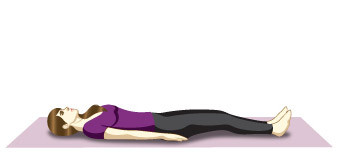
7. Shavasana
(Corpse pose)
- Lie flat on your back, preferably without any props or cushions. Use small pillow below your neck if absolutely required. Close your eyes.
- Keep your legs comfortable apart and let your feet and knees relax completely, toes facing to the sides.
- Place your arms alongside, yet a little spread apart from your body. Leave your palms open, facing upward.
- Taking your attention to different body parts one by one, slowly relax your entire body.
- Begin with bringing your awareness to the right foot, move on to the right knee (as you complete one leg, move your attention on to the other leg), and so on, and slowly move upwards to your head, relaxing each part of the body.
- Keep breathing slowly, gently, deeply and allow your breath to relax you more and more. The incoming breath energizes the body while the outgoing breath brings relaxation. Drop all sense of hurry or urgency or any need to attend to anything else. Just be with the body and the breath. Surrender the whole body to the floor and let go. Make sure you don’t fall asleep!
- After some time, about 10-20minutes when you feel fully relaxed, keeping your eyes closed, slowly roll onto your right side. Lie in that position for a minute or so. Then, taking the support of your right hand, gently sit up into a seated pose such as Sukhasana (Easy Pose).
- Keep your eyes closed and take a few deep breaths in and out as you gradually become aware of your environment and the body. When you feel complete, slowly and gently open your eyes.
Corpse pose is the final resting posture that takes the body into a meditative state and helps repair tissues and cells. Practicing this pose rejuvenates the body and reduces anxiety.
Golf players who have greater flexibility, better stamina and a calm mind stand a higher chance of being better at the game. While you may not be a professional golf player, but yoga can definitely help add more dynamism to your hobby and shield you from probable injuries. Learn more about the benefits of how yoga can enrich your life in a multi-dimensional way at a local The Sri Sri Yoga course.
